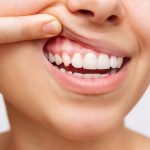Blog
What Does a Healthy Healing Gum Look Like?
Introduction to Healthy Gums
When we think of oral health, teeth often take center stage, but healthy gums are just as crucial for a radiant smile and overall well-being. Gums are the foundation that supports your teeth and act as a protective barrier against harmful bacteria that can lead to infections. Without healthy gums, even the most beautiful teeth can face significant problems.
In this blog, we’ll explore what healthy healing gums look like, how to care for them, and why they’re essential for maintaining long-term oral health.
Characteristics of Healthy Gums
Healthy gums are easy to identify once you know what to look for. Here are the main features that signify excellent gum health:
- Colour:
Healthy gums are generally a shade of pink. However, slight variations—like darker pigmentation in certain ethnic groups—are perfectly normal. - Texture:
Firmness is a hallmark of healthy gums. They should feel resilient when touched, not soft, spongy, or swollen. - Contour:
Healthy gums have a snug fit around each tooth, forming a natural, tight seal that protects the underlying bone. - No Bleeding:
If your gums don’t bleed during brushing or flossing, it’s a good sign they’re healthy. Bleeding often indicates inflammation or the early stages of gum disease.
The Healing Process of Gums After Injury or Surgery
Healing gums go through various stages, and it’s essential to understand what’s normal during this time. Here’s what you can expect:
- Immediate Clotting:
After a dental procedure or injury, a blood clot forms almost instantly to stop bleeding. This is a natural protective mechanism. - Granulation Tissue Formation:
Within the first 48 hours, a whitish layer may appear on the gum surface. This is granulation tissue, an essential part of the healing process. - Tissue Regeneration:
As the days progress, the damaged area will regenerate tissue, eventually blending seamlessly with the surrounding gum. - Final Stages:
By 7-10 days, healthy healing gums begin to return to their normal pink colour and texture. Full recovery might take a few weeks, depending on the extent of the injury or procedure.
How to Maintain Healthy Healing Gums
Keeping your gums healthy, especially during the healing process, requires intentional effort. Follow these practices for the best results:
1. Adopt a Thorough Oral Hygiene Routine
- Brush your teeth twice a day with fluoride toothpaste.
- Floss daily to remove plaque and debris from between your teeth.
- Use an antibacterial mouthwash to reduce bacteria and promote healing.
2. Follow Post-Procedure Instructions
If you’ve undergone dental surgery, your dentist will provide specific aftercare instructions. Follow them diligently to ensure proper healing.
3. Eat a Nutrient-Rich Diet
- Include foods rich in Vitamin C (like oranges and strawberries) to support gum tissue repair.
- Calcium-rich foods, like dairy products, help strengthen bones and teeth.
- Stay hydrated to maintain saliva production, which naturally cleanses your mouth.
4. Avoid Harmful Habits
- Refrain from smoking or using tobacco products, as they slow down healing and increase the risk of gum disease.
- Minimise consumption of sugary snacks and drinks, which can fuel harmful bacteria in your mouth.
5. Visit Your Dentist Regularly
Routine dental check-ups and cleanings are vital for monitoring gum health and addressing potential issues early.
Signs of Unhealthy Gums
Recognising the warning signs of gum problems is just as important as knowing what healthy gums look like. Here are some red flags:
- Persistent Redness or Swelling:
Inflamed gums are often a sign of gingivitis, the earliest stage of gum disease. - Frequent Bleeding:
If your gums bleed often, even with gentle brushing, this could indicate advanced gum problems. - Receding Gum Line:
When gums start to pull back from the teeth, it can expose the tooth root, leading to increased sensitivity and potential decay. - Chronic Bad Breath:
Persistent bad breath that doesn’t go away with regular cleaning can be a symptom of gum disease.
Tips for Healing Gums After Dental Procedures
After a dental procedure, special care is needed to ensure your gums heal correctly.
1. Gentle Cleaning
Switch to a soft-bristled toothbrush and clean your teeth gently. Avoid vigorous brushing near the treated area.
2. Rinse Wisely
Use a prescribed antibacterial mouthwash or a warm saltwater rinse to keep the area clean. Avoid over-the-counter mouthwashes with alcohol, as they can irritate healing tissues.
3. Stick to Soft Foods
Choose soft, non-acidic foods like yoghurt, mashed potatoes, and soup during the initial healing period to avoid irritation.
Why Gum Health is Essential for Overall Well-being
Healthy gums don’t just contribute to a beautiful smile—they’re also vital for your general health. Studies have linked gum disease to several systemic conditions, including:
- Heart Disease:
Chronic gum inflammation has been associated with an increased risk of heart problems. - Diabetes:
Gum disease can make it harder to control blood sugar levels, and vice versa. - Pregnancy Complications:
Gum infections during pregnancy have been linked to preterm births and low birth weight.
Maintaining healthy gums is an investment in your overall health and quality of life.
FAQs About Healthy Healing Gums
1.How long does it take for gums to heal?
It varies depending on the extent of the damage or procedure, but most gums start to feel better within a week and fully heal within a few weeks.
2.Can I speed up the healing of my gums?
Yes! Following your dentist’s instructions, maintaining excellent oral hygiene, and eating a nutrient-rich diet can expedite the process.
3.Should I be worried about white spots on my gums during healing?
Not necessarily. White spots often indicate granulation tissue, a normal part of the healing process. However, consult your dentist if you’re unsure.
Conclusion
Healthy gums are the cornerstone of excellent oral health, providing essential support to your teeth and acting as a shield against harmful bacteria. Whether you’re recovering from a dental procedure or looking to improve your overall gum health, adopting proper oral hygiene and lifestyle habits is key.
For expert advice and personalised care, schedule an appointment with Coburg Dental Group today. We’re committed to helping you achieve and maintain healthy healing gums for life!






